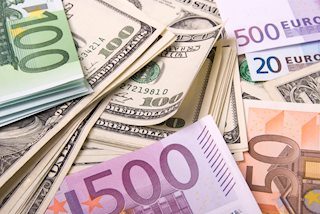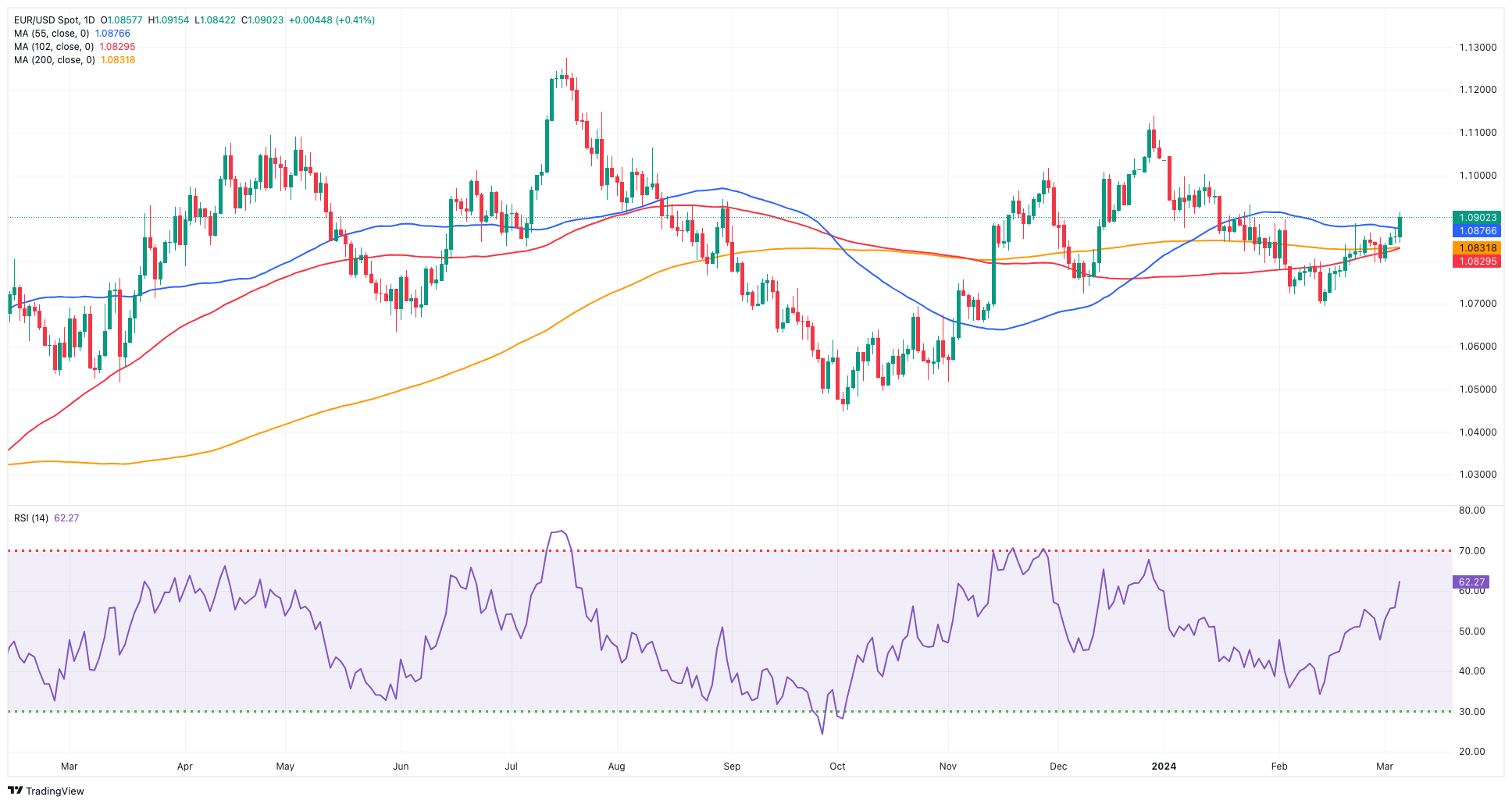EUR/USD Forecast: Next on tap comes 1.1000
Premium|
You have reached your limit of 5 free articles for this month.
Get all exclusive analysis, access our analysis and get Gold and signals alerts
Elevate your trading Journey.
UPGRADE- EUR/USD rose to fresh six-week peaks past 1.0900.
- The leg lower in the Greenback gathered extra pace.
- Investors’ attention now shifts to the ECB gathering.
Finally, EUR/USD managed to surpass the key 1.0900 barrier, advancing to multi-week tops on the back of heightened selling pressure hurting the US Dollar, particularly after discouraging prints from the ADP report and the lack of surprises from Fed Powell’s testimony.
Meanwhile, the USD Index (DXY) retreated for the fourth session in a row, this time hovering over five-week lows in the low-103.00s and accompanied by further losses in US yields, always against the backdrop of steady speculation of a Fed’s rate cut in June.
On the flip side, Germany's 10-year bund yields edged a tad higher after several sessions in the red territory, as prudence gathered pace ahead of the ECB event on Thursday.
Back to Powell, and in his prepared statement, he suggested that interest rate reductions are probable within the year. However, such cuts will only be implemented once the Fed acquires greater confidence in the trajectory of inflation returning to its annual target of 2%.
According to CME Group's FedWatch Tool, expectations of a rate cut in June rose to around 60%.
On the other hand, the ECB is also seen starting its easing cycle in the coming months. On this, ECB Board member Peter Kazimir preferred reducing rates in June, a sentiment reinforced by softening headline inflation figures in Germany and the broader Eurozone last month, contrasting with consistently stable core inflation figures.
Overall, the euro area's stagnant fundamentals compared to the solid resilience of the US economy support the idea of a stronger Dollar in the short term, especially considering the possibility of both the ECB and the Fed starting their easing programmes nearly simultaneously. In such a scenario, EUR/USD could see a deeper correction, initially targeting its year-to-date low around 1.0700 before potentially revisiting lows from late October 2023/early November in the 1.0500 area.
EUR/USD daily chart
EUR/USD short-term technical outlook
EUR/USD may now see successive weekly peaks of 1.0932 (January 24) and 1.0998 (January 11), all before the psychological barrier of 1.1000 and prior to the December 2023 high of 1.1139 (December 28).
On the downside, if the pair breaches the 2024 low of 1.0694 (February 14), it may first target the November 2023 low of 1.0516 (November 1). The loss of the latter may result in a move to the weekly low of 1.0495 (October 13, 2023), ahead of the 2023 low of 1.0448 (October 3) and the round level of 1.0400.
As long as the EUR/USD trades above its 200-day Simple Moving Average (SMA) of 1.0831, the outlook is positive.
Looking at the 4-hour chart, the pair seems to have cleared its way for extra gains in the very near term. That said, the next upward barrier emerges at 1.0932 seconded by 1.0998. The earliest support level is 1.0796, followed by 1.0761, 1.0732, and 1.0694. The Moving Average Convergence Divergence (MACD) remained positive, while the Relative Strength Index (RSI) rose over the 71 mark.
- EUR/USD rose to fresh six-week peaks past 1.0900.
- The leg lower in the Greenback gathered extra pace.
- Investors’ attention now shifts to the ECB gathering.
Finally, EUR/USD managed to surpass the key 1.0900 barrier, advancing to multi-week tops on the back of heightened selling pressure hurting the US Dollar, particularly after discouraging prints from the ADP report and the lack of surprises from Fed Powell’s testimony.
Meanwhile, the USD Index (DXY) retreated for the fourth session in a row, this time hovering over five-week lows in the low-103.00s and accompanied by further losses in US yields, always against the backdrop of steady speculation of a Fed’s rate cut in June.
On the flip side, Germany's 10-year bund yields edged a tad higher after several sessions in the red territory, as prudence gathered pace ahead of the ECB event on Thursday.
Back to Powell, and in his prepared statement, he suggested that interest rate reductions are probable within the year. However, such cuts will only be implemented once the Fed acquires greater confidence in the trajectory of inflation returning to its annual target of 2%.
According to CME Group's FedWatch Tool, expectations of a rate cut in June rose to around 60%.
On the other hand, the ECB is also seen starting its easing cycle in the coming months. On this, ECB Board member Peter Kazimir preferred reducing rates in June, a sentiment reinforced by softening headline inflation figures in Germany and the broader Eurozone last month, contrasting with consistently stable core inflation figures.
Overall, the euro area's stagnant fundamentals compared to the solid resilience of the US economy support the idea of a stronger Dollar in the short term, especially considering the possibility of both the ECB and the Fed starting their easing programmes nearly simultaneously. In such a scenario, EUR/USD could see a deeper correction, initially targeting its year-to-date low around 1.0700 before potentially revisiting lows from late October 2023/early November in the 1.0500 area.
EUR/USD daily chart
EUR/USD short-term technical outlook
EUR/USD may now see successive weekly peaks of 1.0932 (January 24) and 1.0998 (January 11), all before the psychological barrier of 1.1000 and prior to the December 2023 high of 1.1139 (December 28).
On the downside, if the pair breaches the 2024 low of 1.0694 (February 14), it may first target the November 2023 low of 1.0516 (November 1). The loss of the latter may result in a move to the weekly low of 1.0495 (October 13, 2023), ahead of the 2023 low of 1.0448 (October 3) and the round level of 1.0400.
As long as the EUR/USD trades above its 200-day Simple Moving Average (SMA) of 1.0831, the outlook is positive.
Looking at the 4-hour chart, the pair seems to have cleared its way for extra gains in the very near term. That said, the next upward barrier emerges at 1.0932 seconded by 1.0998. The earliest support level is 1.0796, followed by 1.0761, 1.0732, and 1.0694. The Moving Average Convergence Divergence (MACD) remained positive, while the Relative Strength Index (RSI) rose over the 71 mark.
Information on these pages contains forward-looking statements that involve risks and uncertainties. Markets and instruments profiled on this page are for informational purposes only and should not in any way come across as a recommendation to buy or sell in these assets. You should do your own thorough research before making any investment decisions. FXStreet does not in any way guarantee that this information is free from mistakes, errors, or material misstatements. It also does not guarantee that this information is of a timely nature. Investing in Open Markets involves a great deal of risk, including the loss of all or a portion of your investment, as well as emotional distress. All risks, losses and costs associated with investing, including total loss of principal, are your responsibility. The views and opinions expressed in this article are those of the authors and do not necessarily reflect the official policy or position of FXStreet nor its advertisers.
